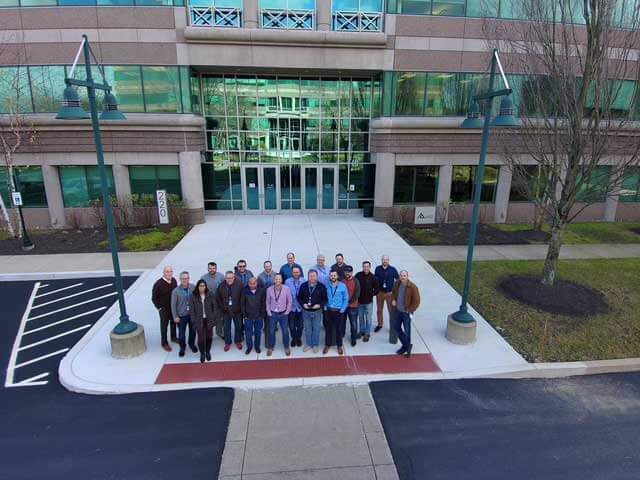By: Chris Corgnati
In the fast-paced world of technology startups and high-tech companies, visionary founders often find themselves juggling multiple roles to get their businesses off the ground…through sheer will power. But how many founders do you know who are brilliant visionaries, skilled leaders and great business operators? The person who truly possesses all three of those skills is a unicorn – very rare indeed.
The reality is that many companies, including in the drone and robotics market, have failed to reach their full potential because they could not execute on a great vision, product or idea. While innovators commonly excel at creating groundbreaking products and services, they may struggle with the operational aspects of running a company.
Enter: the Entrepreneurial Operating System (EOS), a framework designed to help tech entrepreneurs transform their vision into reality. Read on to learn how to unlock the untapped potential of your startup.

The Visionary’s Dilemma
Tech company founders are typically smart visionaries with big ideas. However, the skills required to bring a product to market are vastly different from those needed to run a successful business. As Gino Wickman, author of “Traction – Get a Grip on Your Business,” aptly puts it, “Vision without traction is hallucination.” This is what he means:
Vision: The Guiding Light
Vision refers to a clear, compelling picture of where a business is heading and how it plans to get there. It encompasses the company’s long-term goals and aspirations, its core values and purpose as well as its strategic direction and objectives.
Traction: Turning Vision into Reality
Traction, on the other hand, represents the practical execution of that vision. It involves implementing disciplined, accountable actions, establishing clear processes and systems and consistently executing day-to-day operations that move the company toward its goals.
The Hallucination Effect
Vision alone, no matter how inspiring it might be, remains just an idea without proper execution – like a vivid dream that never materializes in reality. Visions must be translated into actionable steps and tangible outcomes to create real change or value in the business world.
EOS provides a framework to bridge the gap between vision and traction to help leaders avoid the “hallucination” trap.
EOS: The Framework for Success
The EOS serves as an operating system for tech companies to harmonize and synchronize human energy and activities to drive growth and success. It focuses on three critical areas:
- Vision: Ensuring everyone in the organization is aligned with the company’s direction and strategy.
- Traction: Instilling discipline and accountability throughout the company to execute the shared vision effectively.
- Health: Fostering an open, honest, and cohesive leadership team that sets a positive tone for the entire organization.
The Six Key Components of EOS
EOS incorporates research which has shown that successful organizations excel at these six components:
- Vision: Communicating a compelling and shared vision for the company’s future.
- People: Defining and attracting the right talent for your organization.
- Data: Utilizing key metrics to make objective, fact-based decisions.
- Issues: Developing effective problem-solving skills to address challenges permanently.
- Process: Documenting and simplifying core processes for consistency and scalability.
- Traction: Executing the vision with focus, accountability, and discipline.
Bridging Vision and Traction
The EOS provides practical guidance on how your business can become great at the things that other successful organizations do so well. The framework revolves around actionable steps entrepreneurs can take such as:
- Clearly Communicating: Ensuring that everyone in the organization understands and aligns with the vision.
- Having Accountability: Establishing roles, responsibilities and measurable goals for every team member.
- Utilizing Data-Driven Decision Processes: Using key metrics to objectively assess progress and guide actions.
- Conducting Regular Reviews and Making Adjustments: Implementing a rhythm of meetings and check-ins to maintain focus and adapt as needed.
- Documenting Processes: Simplifying and documenting core processes for consistency and scalability.
When vision and traction are effectively integrated in this manner, businesses will experience improved execution of strategic goals, enhanced team alignment and productivity and an increased ability to overcome obstacles and adapt to changes.
Addressing Common Entrepreneurial Challenges
This all may sound easier than done, especially as tech entrepreneurs often face a unique set of challenges in bridging this gap between vision and traction. If these describe you or your business, realize that you are not unique, and you are not alone:
Lack of Control
Many founders feel that their business is running them, rather than the other way around. EOS helps entrepreneurs regain control by providing a framework for time management and strategic decision-making.
People Management
Frustrations with employees, customers, vendors, and partners are common. EOS emphasizes the importance of having the right people in the right roles, to ensure that everyone is on the same page and working towards common goals.
Profit Optimization
Cash flow challenges can lead to poor decision-making. EOS incorporates financial metrics into its framework, helping tech companies optimize their profitability and make data-driven financial decisions.
Breaking Through Growth Plateaus
When growth stagnates, it can be challenging to identify the next steps. EOS provides a roadmap for scaling your tech company, to navigate you through ceilings and reach new levels of success.
Implementing Lasting Change
Many tech companies struggle with implementing lasting change. EOS offers a sustainable approach to improvement. This ensures that new initiatives stick and drive long-term success.
EOS helps entrepreneurs overcome these hurdles.

EOS in Action: Benefits for Tech Companies
The comprehensive set of EOS tools and disciplines provides a structured approach to improve organization, clarity and execution in businesses. Implementing it will yield significant benefits for technology-focused businesses.
Enhanced Innovation and Focus
By defining a clear vision and setting specific, measurable goals, EOS helps tech companies channel their innovative energy more effectively. This clarity drives focused efforts on developing cutting-edge technologies and products.
Improved Execution and Accountability
EOS establishes clear roles and responsibilities, ensuring that team members are accountable for their tasks. This leads to better project execution and faster development cycles for new technologies.
Streamlined Communication
The system emphasizes regular, structured communication through weekly meetings and other tools. This enhanced collaboration among team members results in more efficient problem-solving and execution of tech projects.
Data-Driven Decision Making
In the tech world, data is king. EOS drives the use of data to make informed decisions, helping companies analyze performance metrics, optimize processes, and make strategic decisions that fuel growth.
Scalability for Growth
Especially as tech companies expand, EOS provides a scalable framework that adapts to changing needs. This helps companies manage growth while maintaining operational efficiency and focus on their core technological objectives.
Attracting Investment
An increasing number of venture capital and private equity firms prefer or exclusively invest in companies running on EOS. Tech startups using this system often demonstrate higher effectiveness, profitability, and valuations, making them more attractive to potential investors.
By emphasizing the importance of both visionary thinking and practical execution, EOS helps entrepreneurs and business leaders transform their aspirations into tangible results.
EOS as a Catalyst for Tech Success
Having a solid operational foundation is critical for any company, especially tech companies that face rapidly evolving and volatile markets. EOS has already been implemented by over 29,000 companies worldwide, with 850+ professional EOS implementers conducting more than 190,000 full-day sessions. It provides the critical foundation that allows tech leaders to focus on what they do best – create groundbreaking products and services – while ensuring their businesses run smoothly and efficiently.
Bob Hammett, CEO of OneSky, a leading UAS Traffic Management (UTM) company developing airspace assessment, operations, and traffic management solutions for the aviation industry attested:
“We have been on our EOS journey since spinning out of AGI 5 years ago, and I know we could not have achieved what we have without EOS. It has given us the structure and discipline to adapt and thrive through a very volatile time in the UAS industry. By sticking to our core values and processes, we have been able to continue to innovate as the market changes and it ensured we were better prepared to overcome adversity. By always going back to our vision and reassessing our traction every 90 days, we stay focused on our long-term goals and drive that down into quarterly priorities that are crystal clear for the company and every member of the leadership team. As the CEO, EOS allows me the time and space to think and engage outside of the company to drive our growth knowing that the company is aligned and focused and will continue to operate smoothly because of the work we have done with EOS.”
Do you want to ensure that your vision becomes a reality rather than remaining a mere “hallucination”? Schedule a free 90 minute session to learn more about the EOS and determine if it is a good fit for you and your business. Visit www.EOSworldwide.com/chris-corgnati or contact chris.corgnati@eosworldwide.com for more information.
*The author, Chris Corgnati, is a Professional EOS Implementer® at EOS Worldwide.
The five common frustrations addressed by EOS:
- Lack of control
- People issues
- Profit challenges
- Growth stagnation
- Ineffective strategies
The six key components of the EOS Model:
- Vision
- People
- Data
- Issues
- Process
- Traction
By: Chris Corgnati

